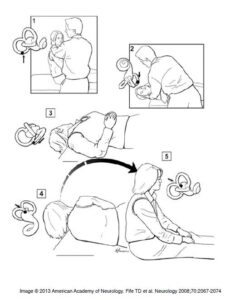Dizziness and vertigo are among the most common reasons for emergency room visits and primary care consultations. In the Fredericksburg and Spotsylvania areas, these symptoms can be distressing and disruptive, often leading patients to seek immediate relief. At Stine Chiropractic Orthopedics, our board-certified chiropractic orthopedists provide advanced diagnosis and non-surgical treatment for dizziness and vertigo. By combining orthopedic-level diagnostic precision with evidence-based chiropractic care, we identify the true cause of symptoms and guide patients toward lasting recovery.
Understanding Dizziness and Vertigo Vs Dysequilibrium
Dizziness and vertigo are broad terms used to describe sensations of imbalance, spinning, or unsteadiness. Dysequilibrium refers to a disturbed sense of spatial orientation, while vertigo specifically refers to the false sensation that you or your surroundings are moving. These symptoms arise when the body’s equilibrium systems—the visual, vestibular, and cervical proprioceptive mechanisms—are disrupted.
The Equilibrium Triad
Balance and orientation is maintained by three major systems that work together to inform the brain of body position and motion:
- Visual System: Provides spatial orientation through visual reference points.
2. Vestibular System: Located in the inner ear, it includes the semicircular canals, saccule, and utricle, which detect head acceleration and changes in position relative to gravity.
3. Cervical Proprioceptive System: Sensory receptors in the neck muscles and joints detect head and body movement, relaying this information to the vestibular system.
When one or more of these systems are impaired, dizziness or vertigo can occur. A chiropractic orthopedist is trained to evaluate all three components to determine the underlying cause.
Common Causes of Dizziness and Vertigo
There are numerous causes of dizziness and vertigo. The most frequently encountered include benign paroxysmal positional vertigo (BPPV), cervicogenic dizziness, and vestibular disorders such as labyrinthitis and Meniere’s disease.
Benign Paroxysmal Positional Vertigo (BPPV)
BPPV is the most common cause of vertigo and occurs when small calcium carbonate crystals (otoconia) within the inner ear become dislodged and migrate into one of the semicircular canals. This disrupts normal fluid movement, leading to brief but intense episodes of vertigo when the head changes position. Patients often experience dizziness when rolling over in bed or looking upward. Chiropractic orthopedists perform specific diagnostic maneuvers to confirm BPPV and can guide patients through corrective exercises such as the Epley’s maneuver, which repositions these crystals.
Cervicogenic Dizziness
Cervicogenic dizziness arises from dysfunction in the cervical spine, often related to whiplash injury, degenerative changes, or poor posture. The upper cervical region contains a high concentration of proprioceptive receptors that coordinate head and body position. When these receptors send inaccurate signals to the brain, a sense of imbalance or dizziness can occur. Manual spinal manipulation and targeted rehabilitation performed by a chiropractic orthopedist can restore proper proprioceptive function and alleviate symptoms.
Vestibular and Neurologic Causes
Other vestibular conditions include labyrinthitis, vestibular neuronitis, and Meniere’s disease. Labyrinthitis and vestibular neuronitis are often caused by viral infections and result in acute, sudden-onset vertigo that resolves gradually over weeks. Meniere’s disease involves excessive fluid pressure within the inner ear, leading to episodic vertigo, hearing loss, tinnitus, and ear fullness. A chiropractic orthopedist can differentiate these conditions from cervical or vascular causes through a detailed clinical examination.
Vascular and Systemic Causes of Dizziness
Dizziness can also arise from vascular causes such as vasovagal syncope, orthostatic hypotension, or carotid sinus sensitivity. In these cases, decreased blood flow to the brain leads to lightheadedness or near-fainting episodes. It is critical to differentiate these from vestibular causes, as treatment approaches differ. A chiropractic orthopedist can identify when referral for cardiovascular evaluation is necessary.
Diagnostic Approach by a Chiropractic Orthopedist
Board-certified chiropractic orthopedists are uniquely qualified to assess both musculoskeletal and neurological components of dizziness. A detailed history, positional testing, vestibular function assessment, and cervical evaluation help determine the origin of symptoms. Imaging such as X-ray or MRI may be recommended if structural abnormalities or central causes are suspected.
Evidence-Based Conservative Management
Treatment is based on the identified cause and may include canalith repositioning maneuvers for BPPV, cervical mobilization for cervicogenic dizziness, or vestibular rehabilitation for balance retraining. Additional therapeutic options include interferential current therapy, proprioceptive retraining, and home exercise programs designed to restore equilibrium. These non-surgical interventions aim to correct the dysfunction rather than simply mask the symptoms.
When to Seek Chiropractic Orthopedic Evaluation
If you experience recurrent dizziness, vertigo, or imbalance that interferes with your daily activities, professional evaluation is recommended. At Stine Chiropractic Orthopedics, our board-certified chiropractic orthopedists integrate orthopedic diagnostic precision with advanced conservative care to identify and address the root cause of your symptoms.
Schedule an Appointment
Do not allow dizziness or vertigo to limit your quality of life. Contact Stine Chiropractic Orthopedics at (540) 898-4100 or visit us online at stinechiro.com to schedule a comprehensive evaluation today. Our team provides expert, non-surgical management for dizziness and vertigo in Fredericksburg and Spotsylvania.
Frequently Asked Questions
What is the difference between dizziness and vertigo?
Dizziness is a general term for unsteadiness or lightheadedness, whereas vertigo is a specific sensation of spinning or movement, either of the body or the environment.
Can chiropractic care help with dizziness and vertigo?
Yes. Chiropractic orthopedists use specialized orthopedic and vestibular assessments to identify mechanical and neurologic causes of dizziness, allowing for precise, non-surgical management.
What is BPPV and how is it treated?
Benign Paroxysmal Positional Vertigo (BPPV) is caused by displaced crystals in the inner ear. It is treated with canalith repositioning maneuvers, such as the Epley’s maneuver, which restore normal inner ear function.
When should I seek medical attention for dizziness?
Seek evaluation if dizziness is persistent, accompanied by hearing loss, headaches, double vision, weakness, or difficulty walking. These may indicate more serious neurological or vascular causes.

The use of the Epley’s maneuver. Used commonly in posterior canal BPPV. One of the causes of dizziness or vertigo.







